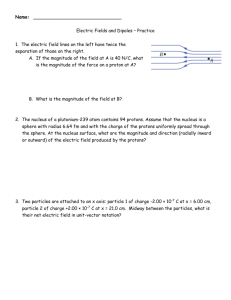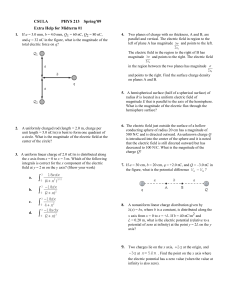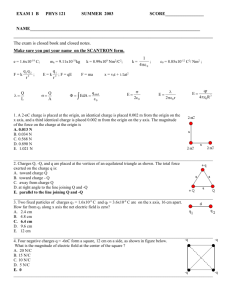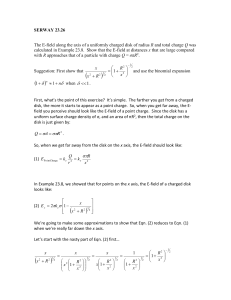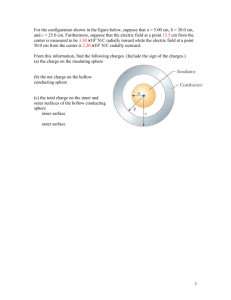Problem Set 2
advertisement
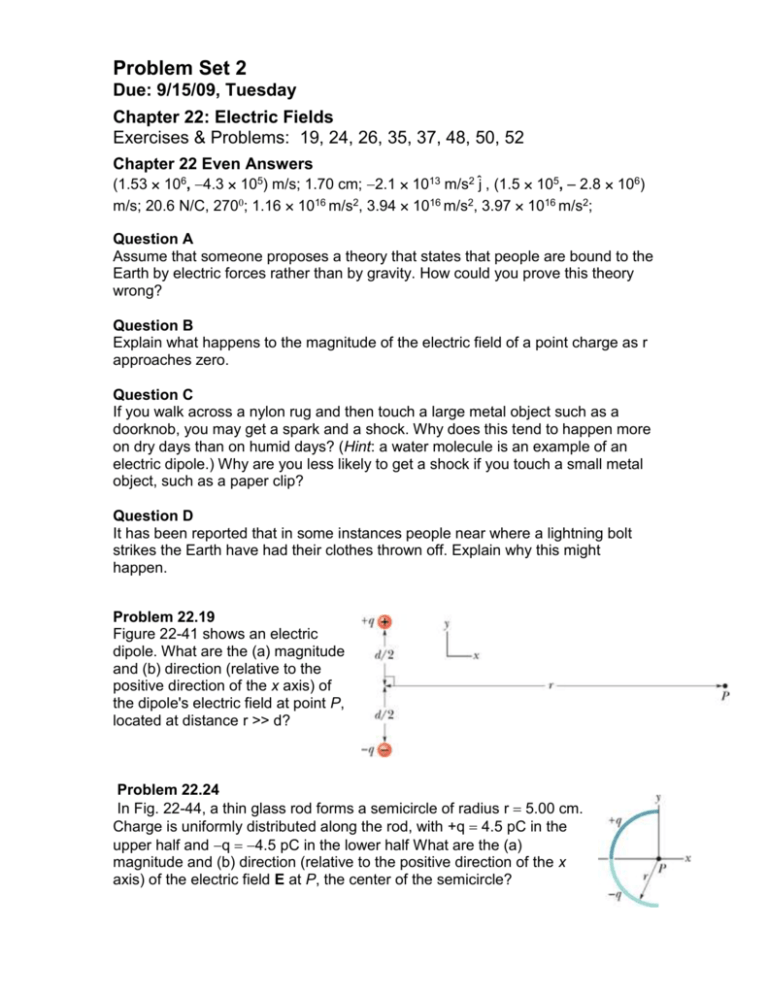
Problem Set 2 Due: 9/15/09, Tuesday Chapter 22: Electric Fields Exercises & Problems: 19, 24, 26, 35, 37, 48, 50, 52 Chapter 22 Even Answers (1.53 106, 4.3 105) m/s; 1.70 cm; 2.1 1013 m/s2 ĵ , (1.5 105, – 2.8 106) m/s; 20.6 N/C, 270; 1.16 1016 m/s2, 3.94 1016 m/s2, 3.97 1016 m/s2; Question A Assume that someone proposes a theory that states that people are bound to the Earth by electric forces rather than by gravity. How could you prove this theory wrong? Question B Explain what happens to the magnitude of the electric field of a point charge as r approaches zero. Question C If you walk across a nylon rug and then touch a large metal object such as a doorknob, you may get a spark and a shock. Why does this tend to happen more on dry days than on humid days? (Hint: a water molecule is an example of an electric dipole.) Why are you less likely to get a shock if you touch a small metal object, such as a paper clip? Question D It has been reported that in some instances people near where a lightning bolt strikes the Earth have had their clothes thrown off. Explain why this might happen. Problem 22.19 Figure 22-41 shows an electric dipole. What are the (a) magnitude and (b) direction (relative to the positive direction of the x axis) of the dipole's electric field at point P, located at distance r >> d? Problem 22.24 In Fig. 22-44, a thin glass rod forms a semicircle of radius r 5.00 cm. Charge is uniformly distributed along the rod, with +q 4.5 pC in the upper half and q 4.5 pC in the lower half What are the (a) magnitude and (b) direction (relative to the positive direction of the x axis) of the electric field E at P, the center of the semicircle? Problem 22.26 Charge is uniformly distributed around a ring of radius R 2.40 cm, and the resulting electric field magnitude E is measured along the ring's central axis (perpendicular to the plane of the ring). At what distance from the ring's center is E maximum? Problem 22.35 At what distance along the central perpendicular axis of a uniformly charged plastic disk of radius 0.600 m is the magnitude of the electric field equal to onehalf the magnitude of the field at the center of the surface of the disk? SSM Problem 22.37 Suppose you design an apparatus in which a uniformly charged disk of radius R is to produce an electric field. The field magnitude is most important along the central perpendicular axis of the disk, at a point P at distance from the disk (Fig. a ). Cost analysis suggests that you switch to a ring of the same outer radius R but with inner radius R/2.00 (Fig. b ). Assume that the ring will have the same surface charge density as the original disk. If you switch to the ring, by what percentage will you decrease the electric field magnitude at P? Problem 22.48 At some instant the velocity components of an electron moving between two charged parallel plates are vx 1.5 105 m/s and vy 3.0 103 m/s. Suppose the electric field between the plates is given by E = (120 N/C) ĵ . In unit-vector notation, what are (a) the electron's acceleration in that field and (b) the electron's velocity when its x coordinate has changed by 2.0 cm? Problem 22.50 In Fig. 22-55 , an electron is shot at an initial speed of v0 2.00 106 m/s, at angle 40.00 from an x axis. It moves through a uniform electric field E = (5.00 N/C) ĵ . A screen for detecting electrons is positioned parallel to the y axis, at distance x 3.00 m. In unit-vector notation, what is the velocity of the electron when it hits the screen? Problem 22.52 In Fig. 22-57, an electron (e) is to be released from rest on the central axis of a uniformly charged disk of radius R. The surface charge density on the disk is +4.00 C/m2. What is the magnitude of the electron's initial acceleration if it is released at a distance (a) R, (b) R/100, and (c) R/1000 from the center of the disk? (d) Why does the acceleration magnitude increase only slightly as the release point is moved closer to the disk? Explain your answer using short concise sentences.
